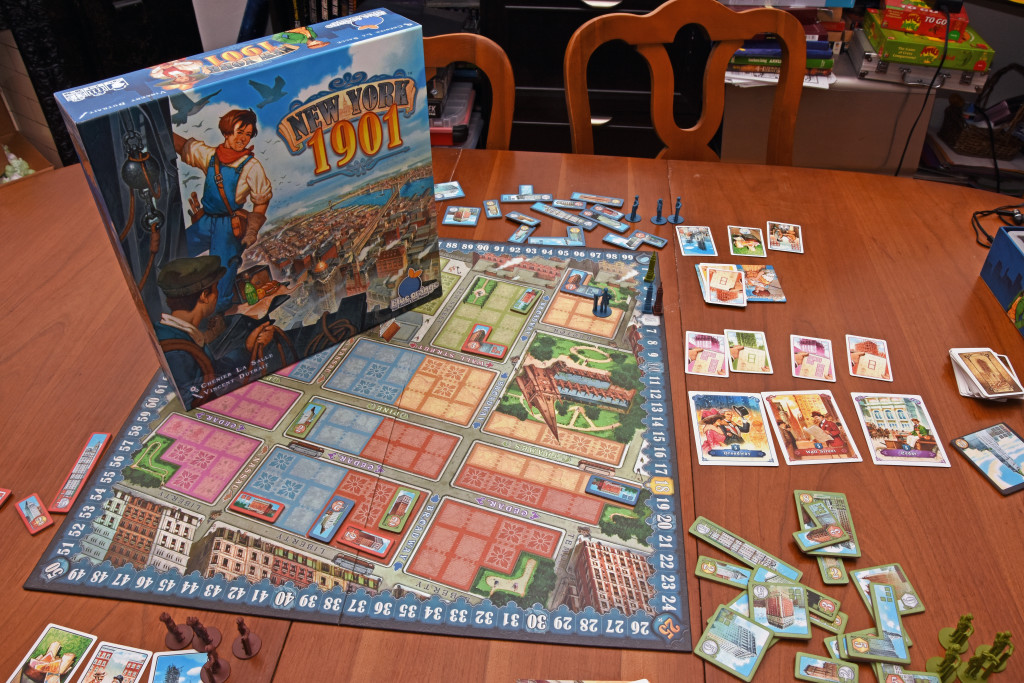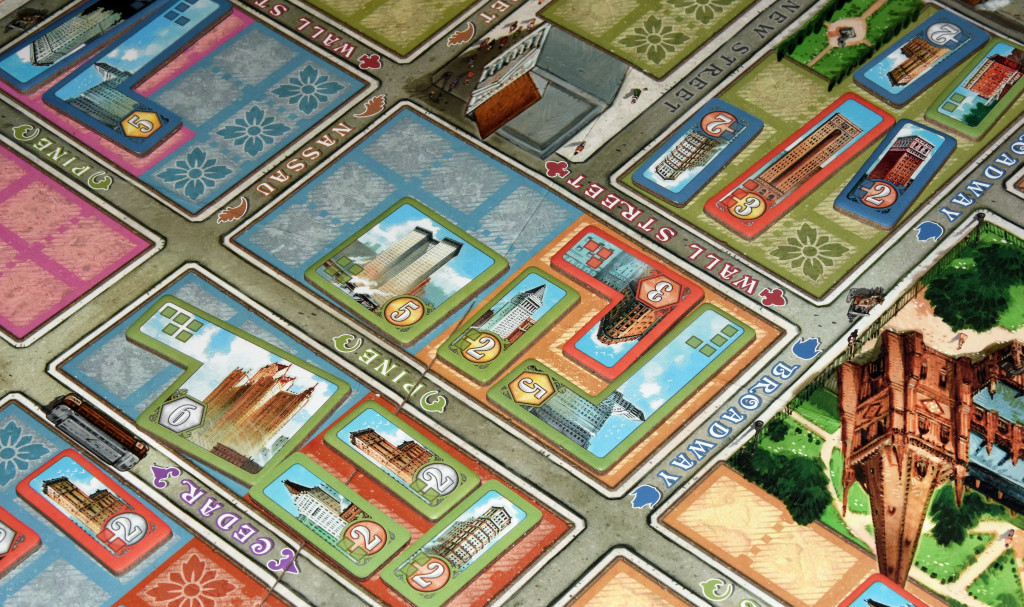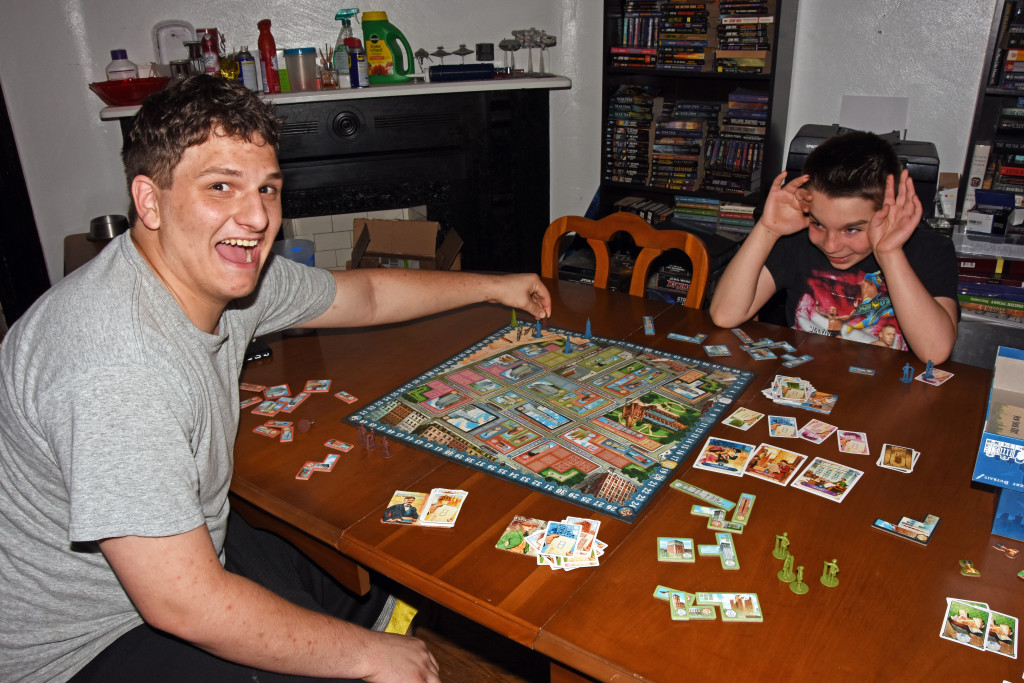Games like “Suburbia” and “Sunrise City” appeal to me because of how much they resemble “SimCity“, though they admittedly can take a while to play. “New York 1901”, brought to you by the same folks who released “BraveRats“, simplify things a bit in this skyscraper builder. Instead of worrying about residential, commercial, and industrial zones, players will simply be trying to build skyscrapers (via tetromino pieces) in order to score points. Before I go any further, I’d like to thank the folks at Blue Orange Games for reaching out and providing me with a free press copy for review purposes. While the game won’t be available until August, 2015, I’m told that my copy is for the most part representative of the final product.
Components
The game includes 1 Game Board, 5 Character Cards, 5 Streets of New York Bonus Cards, 5 Bonus Challenge Cards, 65 Lot Cards, 4 Skyscraper Scoring Markers (1 per player), 16 Workers (4 per player), 4 King Tokens (1 per player), 12 Action Cards (3 per player), 76 Skyscraper Tiles (19 per player), and 4 Legendary Skyscraper Tiles (1 per player).
Setup & Gameplay
There’s an entire page dedicated to game setup so in order to keep the review moving, I’ll opt to skip that part. Suffice it to say that each player gets a scoring marker, 18 skyscraper tiles, 1 king token, 4 workers, 3 action cards, and a character card chosen at random. They’ll get to place their starting property on the board as directed on their character card. The youngest player goes first.
The game is broken up over a series of turns with the active player being able to do one of two actions:
1. Acquire Land and/or Building – The player may take a lot card from the open market and place one worker on an empty slot of land on the board of the corresponding size and color. As an optional action, the player can then place one skyscraper tile on a previously acquired lot and score points.
2. Demolish and Rebuild – The player may demolish a building and build one new building of a more advanced age in the space freed by the demolition and score points.
A player may also use action cards (one time use) to give themselves an edge that turn. At the end of their turn, the active player will replenish the open market for the next player by drawing from the deck. The game ending condition will trigger if there aren’t enough cards in the deck to replenish the open market. That, or when a player has only 4 unbuilt skyscraper tiles remaining. Players observe their points (there’s a score track along the perimeter of the board) and add any appropriate bonuses (Streets of New York Bonus Card, Bonus Challenge Cards, unused Action Cards, etc.). The player with the most points, wins!
Editor’s Note: The above doesn’t cover all of the rules found in the manual, but should give you the general idea as to how the game is played.
The Review
“New York 1901” has a lot going on despite its simplistic gameplay. For one, I like the fact that skyscraper tiles can be bronze, silver, gold, or legendary. Players start off with bronze buildings that don’t provide a lot of points. Yet, it’s necessary to build them so that you can reach the next milestone on the score track, which allows you to do build the next tier of building (silver, then gold). Once players start unlocking these tiers, they can opt to either demolish/upgrade their bronze structures or simply build the more advanced structures on plots they either have reserved or at some point will acquire. Be warned…gold structures can’t be demolished! While they score a decent bundle of points, you can’t demolish them in order to pave the way for even larger structures (like legendary buildings).
With that said, the bonus cards to encourage players to step outside the normal strategy a bit. The Streets of New York Cards, for example, will award players five bonus points to whomever has the most skyscrapers on that street at the end of the game (the plots on the board are divided into districts of a particular color, separated by streets). So while upgrading seems like the logical choice, you might opt to instead build a bunch of bronze on a particular section to reserve that end-of-game bonus. The Bonus Challenge Cards are similar in that they are hidden objectives each player is dealt at the start. The Bronze Baron Bonus Challenge Card, for example, awards bonus points for having 4, 5, or 6 bronze skyscrapers on the board at the end of the game.
The learning curve comes into play mostly with regard to the building rules. There are several bullet points across both player actions that limit their possibilities, though it’s not overly complicated to the point where players will scratch their heads deciphering the particulars. With that said, you’ll probably want to have the rule book handy for your first few games so that you’re not missing anything important. I was admittedly confused on the character colors and the icons on the cards…you may have a character card with a blue background, but the icon on said card (a different color) determines where your starting property goes. Further, the color tiles you choose may not match the background color of the character card you receive…I had to reread game setup multiple times to understand what it was the game was trying to accomplish. Besides that, the game is relatively easy to play and suitable for kids of most ages. “New York 1901” is like a light version of “SimCity”, minus the smog, crime, and traffic.
All in all, “New York 1901” is a solid (albeit light) city-builder ideal for family game night.
Final Verdict: 7/10
Editor’s Note: This game is set to release sometime in August, 2015.
—
You can learn more about “New York 1901” by visiting the official website, here:



